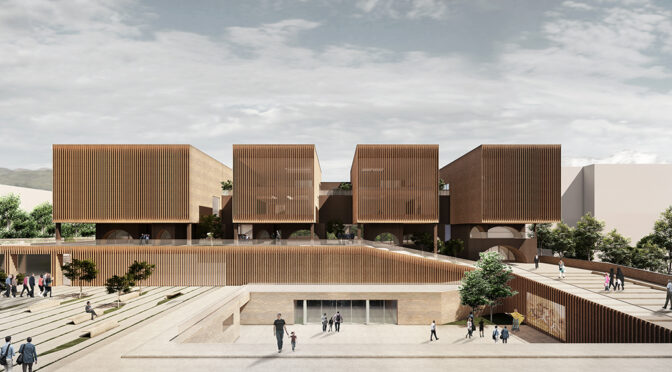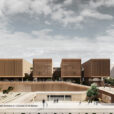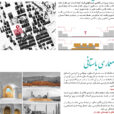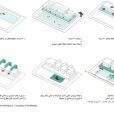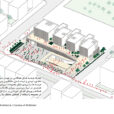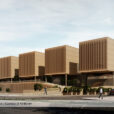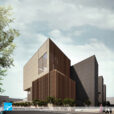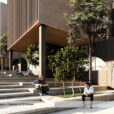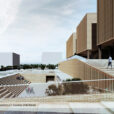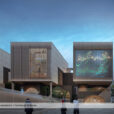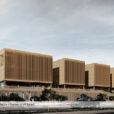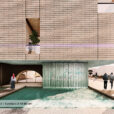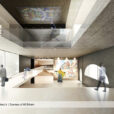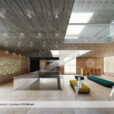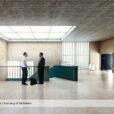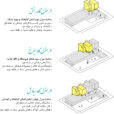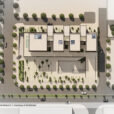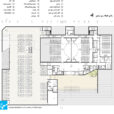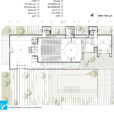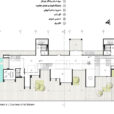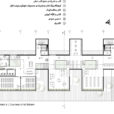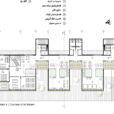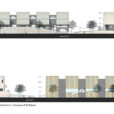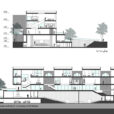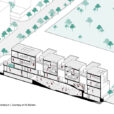خردسرای فردوسی
علی بیدرام
موقعیت: مشهد، ایران
تاریخ: ۱۳۹۹
مساحت: ۸۰۰۰ مترمربع
وضعیت: طرح پیشنهادی مسابقه / رتبه دوم
کارفرما: موسسه فرهنگی هنری خردسرای فردوسی
تیم پروژه: سروش سبزواری، ساناز شعبانی نودهی، محمد مرتاض هجری
همانگونه که میدانیم، هر هنری، از جمله شعر، موسیقی، نقاشی، معماری و … دارای دو بخش جداییناپذیر صورت و محتوا است، و صورت یا فرم در راستای انتقال محتوای موردنظر مولف آن هنر انتخاب میشود. صورت و قالب شاهنامه نیز به دلیل وجود عنصر روایتگری در آن، مثنوی انتخاب شده است و مصرعهای شاهنامه بر وزن «فَعولُن فَعولُن فَعولُن فَعَل» هستند که دارای ضربآهنگی سنگین و حماسی است. از طرف دیگر، محتوای روایتگونه شاهنامه، بهطور کلی، تقابل، دوگانگی و تضاد خیر و شر را به تصویر میکشد. بر این اساس، تصمیم بر آن شد که این روایت تقابل خیر و شر، و همچنین وزن سنگین مصرعها بر فرم معماری ما اثرگذار باشد، بدینصورت که با قرارگرفتن چهار مکعب که بر وزن «فَعولُن فَعولُن فَعولُن فَعَل» شکل و هندسه مییابند، فرم غالب طرح به وجود آید.
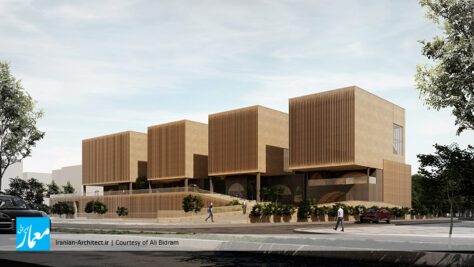
موضوع دیگر که به آن اشاره کردیم، روایت تقابل خیر و شر در شاهنامه است. برای تبدیل این محتوا به صورت معماری، چهار مکعب معلق و آزاد (نماد خیر و نیکی) را در تقابل با سه مکعب صلب پایبسته بر زمین (نماد شر و بدی) که دارای متریال و جهتی متفاوت هستند، قرار دادیم، بهگونهای که این سه مکعب در نمای شمال، و چهار مکعب قبلی در نمای جنوب، غالب هستند. تقابل این هفت مکعب با یکدیگر، باعث ایجاد هفت عرصه در پلان پروژه شد که توالی و چیدمان خطی این هفت عرصه، علاوه بر داشتن نقش عملکردی، اشارهای به هفتخان رستم و مسیری که او طی میکند، دارد. این مسیر هفتخان در فضای داخلی طبقه اول نیز بازنمایی، و در نهایت، به آبنمایی در جبهه غربی پروژه که نماد حیات و زندگانی است، منتهی میشود.
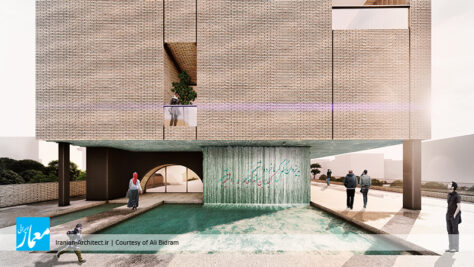
با توجه به اهمیت مفهوم خرد در این پروژه، فرمی که ما را به این مفهوم نزدیک میکرد، حجمی با ظاهری وزین و درونی شفاف بود که به عنوان نماد دانایی و خرد، بهگونهای آزاد و معلق، روی یک صفه قرار میگیرد و در زیر این مکعب، طالبان خرد میتوانند از این منبع بهرهمند شوند. شفافیت احجام نیز از طریق ایجاد وید و سقفهای شیشهای قابل درک است. از طرف دیگر، توجه به تاریخ و اسطورههای ایران کهن در شاهنامه، ما را بر آن داشت تا در خردسرای فردوسی از دو الگوی فرمی معماری ایرانی، یعنی صفه (که باعث یک نوع وقار و عظمت برای پروژه میشود) و طاقهای مازهدار استفاده کنیم.
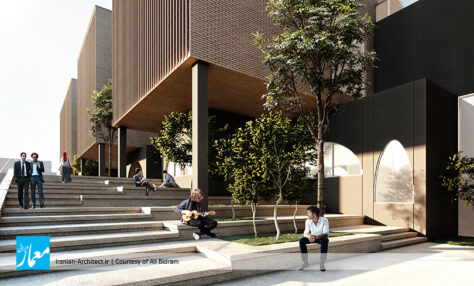
سایت پروژه در یک بافت مسکونی قرار گرفته است که این بافت مانند اغلب بافتهای مسکونی امروزی، دارای هندسهای چهارگوش در سایتپلان، و مکعبهایی در توده شهر است. در نتیجه، حجم پروژه در امتداد این بافت شهری در نظر گرفته شد، و تقسیمات حجمها نیز به منظور مطابقت بیشتر با بافت کوچکمقیاس شهری صورت پذیرفت تا علاوه بر حفظ هندسه در سایت و خط آسمان، حجمی نامانوس برای ساکنین منطقه شکل نگیرد. همچنین سایت و بنا به نحوی طراحی شدند که در ارتباط با شهر و مردم عمل کرده و زمینه لازم برای ایجاد تعامل اجتماعی را فراهم کنند. از اینرو، امکان تجمع افراد، و پیوستگی فضاهای جمعی در سه سطح، از مواردی بود که در طراحی سایت و صفه مورد توجه قرار گرفت.

با توجه به قرارگیری مشهد در اقلیمی که هم از زمستانهای سرد و هم از تابستانهای گرم برخوردار است، توجه به راهکارهایی که در عین کمهزینگی، شرایط آسایش را در تمام فصول فراهم کنند، مورد توجه قرار گرفت. تنوع موجود در فضاها در ارتباط با فضای بیرونی (باز، بسته و نیمهباز)، امکان برگزاری اجتماع در شرایط و فصول متفاوت را فراهم میکند. برای جدارههای مجموعه نیز از دیوار دوجداره و آجر که ظرفیت حرارتی بالایی دارد، استفاده شده است. همچنین ورودیها با دو درب طراحی شدهاند که نقش مهمی در کاهش مصرف انرژی و کنترل هوای داخلی دارد. اختصاص بیشترین سطح بازشوها در جنوب و شمال، از دیگر مواردی است که به منظور توجه به طراحی اقلیمی صورت پذیرفته است.
بنای خردسرا در پنج مرحله قابل ساخت و بهرهبرداری است. نکتهای که برای تیم طراحی اهمیت داشت، ایجاد هویت برای هر فاز از ساخت و بهرهبرداری بود. برای این منظور، برای هر فاز، نامی از شاهنامه مطابق با عملکرد آن فاز انتخاب شد:
ـ مرحله اول (صفه فرهنگ): ساخت طبقه زیرزمین و همکف، شامل فضاهای اداری، سالن کنفرانس، تالارهای همایش، نگارخانه، پارکینگ و تاسیسات
ـ مرحله دوم (منزلگاه رخش): ساخت کتابخانه و موزه اسناد، شامل موزه و مخزن کتب و یادگارهای فرهنگی در طبقه اول؛ کتابخانه و نشریات در طبقه دوم؛ مدیریت، پژوهش و تولید نشریه در طبقه سوم
ـ مرحله سوم (منزلگاه سیمرغ): ساخت فروشگاه و کافهکتاب، شامل یادگارهای فرهنگی در طبقه اول؛ فروشگاه بزرگ کتاب و محصولات فرهنگی در طبقه دوم؛ سکوی نقالی و فضای پذیرایی سبک در طبقه سوم
ـ مرحله چهارم (منزلگاه سیاوش): ساخت فضای کتابخانه و کودکان، شامل نمایشگاه و فضای خلاقیت در طبقه اول؛ تالار مطالعه کودک در طبقه دوم؛ فضای نمایش کودک و فضای پذیرایی در طبقه سوم
ـ مرحله پنجم (منزلگاه حیات): ساخت فضاهای آموزشی (کلاس، کارگاه، مدیریت، خدماتی)، با دسترسی جدا از روی صفه
Ferdowsi Cultural Center
Ali Bidram
Location: Mashhad, Iran
Date: 2021
Area: 8,000 sqm
Status: Competition Proposal / 2nd Place
Client: Kheradsaraye Ferdowsi Institute
Project Team: Soroush Sabzevari, Sanaz Shabani Nodehi, Mohammad Mortaz Hejri
As we know, every art, including poetry, music, painting, architecture, etc. has two inseparable parts of form and content, and the form is selected to convey the content desired by the author of that art. The form of Shahnameh has been chosen as ode (Masnavi), due to the presence of a narrative element in it, and the verse of Shahnameh are on a meter (poetry weight) that has a heavy and epic rhythm. On the other hand, the content of Shahnameh narrative depicts the opposition, duality and conflict of good and evil, in general. Based on this, it was decided that this narrative of the opposition of good and evil, as well as the heavy weight of the verses, will affect our architectural form; So that, by placing four heavy cubes (which represents the meter of Shahnameh verses), the dominant design form appears.
Another subject that we mentioned, is the narration of the opposition of good and evil in Shahnameh. To turn this content into an architectural form, we placed the four suspended and free cubes (symbol of goodness), in contrast to the three rigid cubes standing on the ground (symbol of evil) that have different materials and directions. These three cubes dominate in the north view, and four cubes in the south view. The confrontation of these seven cubes with each other, created seven arenas in the project plan. The sequence and linear arrangement of these seven arenas, in addition to its functional application, refer to Rostam’s Haft-Khan and the path he takes. This Haft-Khan route is represented in the interior of the first floor, and finally, leads to the fountain, on the west side of the project, which is a symbol of life.
Ferdowsi and other writers consider wisdom or knowledge to be the most precious blessing that God has given to human beings. Man’s choice over other creatures is due to his wisdom, and wisdom recognizes good and evil, right and wrong, profit and loss. According to the concept of wisdom, the form that brought us closer to this concept, was a volume with a weighty appearance, and a clear interior, as a symbol of wisdom, which is placed freely and suspended on a platform, and below this cube, the seekers of wisdom can benefit from this resource. The transparency of these volumes can be understood through the creation of void and glass ceilings.
Shahnameh consists of three parts: myth, heroism and historical. Attention to the history and myths of ancient Iran in the Shahnameh, led us to use the formal patterns of Iranian architecture (before Islam) in the project:
– Soffeh: A flat surface with a level above ground level, that was created in Persepolis for the construction of palaces on it. Using this model, in addition to creating a kind of grandeur and dignity in the building, creates a platform for social and cultural events.
– Arches: In Persian architecture, this type of arches has been used a lot to cover the building.
The project site is located in a residential context. This texture, like most residential textures today, has a rectangular geometry at the site, and cubes in the city mass. As a result, the desired volume was considered along this urban texture, and the method of dividing the volumes was done in order to be more in line with the small texture of the urban scale; So that, in addition to maintaining geometry at the site and skyline, it is not an unfamiliar volume for residents. The site and the building were also designed to act in relation to the city and the people, to provide a place for social interaction. The possibility of gathering people and the continuity of collective spaces on three levels, were also among the issues that were considered in the design of the site and the platform.
Due to the location of Mashhad in a climate that has both cold winters and hot summers, should attention was paid to solutions that provide comfort in all seasons while being low cost. The variety of spaces in relation to the outdoor space (open, closed and semi-open), allows holding a community in different conditions and seasons. For the walls of the complex, double-walled walls and bricks that have a high heat capacity, have been used. The entrances are designed with two doors, which play an important role in reducing energy consumption and controlling indoor air. Allocating the highest level of openings in the south and north, is another thing that has been done in order to pay attention to climate design.

